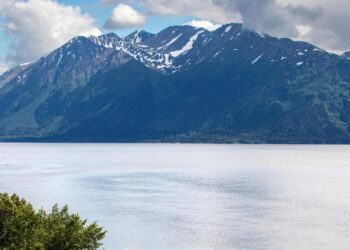Europe received all the glory for its 19th-century spa towns, lavishly built around healing hot springs and uber-elaborate with their colonnades, water galleries, pump rooms, and fancy hotels. But the U.S. had its share of bourgeoisie spa towns, too. With limited therapies available to treat ailments like rheumatism and arthritis, doctors would ‘prescribe’ mineral-rich hot springs to patients in roaring-spring places like Arkansas, Texas, New York, and West Virginia. While many of the original thermal towns have gone the wayside, a few still remain. Among those worth traveling for:
Hot Springs, Arkansas History
The area known today as Hot Springs National Park became U.S. territory in 1803 (as part of the Louisiana Purchase). The first permanent settlers were reportedly so enamored with the miracle waters, they constructed log cabins around the pools; placed wooden planks across the top of the springs as seating. A century later, Hot Springs was a bonafide spa town, home to a fancy promenade where the elite paraded in their finery and sipped the healing waters from goblets before slipping off to Bathhouse Row — eight grand bathhouses built over top the springs.
Modern-Day Allure
Only one of Bathhouse Row’s original spas, Buckstaff Bathhouse, remains in operation, and blissfully offers the same water cure as it did in its spa heyday. Water from the 144-degree hot springs (high in silica, calcium, magnesium, free carbon dioxide, bicarbonate, and sulfate) is siphoned in for restorative soaks; the original bathtubs and equipment (renovated and finely tuned) are still used. Next door, the reimagined (circa 1922) Quapaw Bathhouse, offers four modern communal soaks, along with private baths and a steam cave, while the also-historic (circa 1916) Superior Bathhouse has reopened (and rebranded) — as a brewery, reportedly producing the world’s only thermal beer.
Berkeley Springs, West Virginia
The History
While many can claim George Washington “slept here,” Berkeley Springs — America’s first spa — can boast that he bathed here, too. Young George was only 16 when he came upon the bubbly waters and for decades later was a frequent visitor. In 1776, the Virginia Legislature incorporated America’s first spa town as Bath (a taunt to England) and constructed five bathhouses — including the Old Roman and Main Bathhouses still in use today. The town changed its name to Berkeley Springs in 1802.
Modern-Day Allure
Just 90 minutes from the Washington D.C. and Baltimore metro area, Berkeley Springs is a popular day trip and weekend getaway. Today the town is home to art galleries, restaurants, homeopathy shops, and of course spas. The historic Roman Bathhouse offers private (and couples) soaks in the heated (102-degrees) mineral waters. The Main Bathhouse offers additional bathing options along with massage and a cedar sauna. A more modern spa experience comes at the 11-treatment-room Atasia Spa, featuring authentic Thai massage and Dead Sea mud treatments — all start with a warm mineral soak. For the town’s most luxurious spa experience, head to the restored The Country Inn’s hilltop Renaissance Spa, offering thermal-water treatments in private rooms overlooking town.
Saratoga Springs, New York
The History
Although President Franklin D. Roosevelt preserved Saratoga’s famous spring waters in 1935, the naturally carbonated mineral waters came into popularity more than a century before. With the advent of the railroad in 1832, tourism burgeoned — doctors sent patients to soak in the curative waters, elaborate bathhouses were constructed, and elegant hotels sprung up for the ritual of walking the promenade, breathing the fresh air, and ‘taking the waters.’ Roosevelt’s designation of a spa park included a drinking pavilion, concert hall, the Roosevelt baths, Gideon Putnam Hotel, swimming pool, tennis courts, and golf course. By the 1940s, a three-week ‘kur’ — which included 21 mineral baths, diet, exercise, and drinking up to 20 cups of water per day — was the norm.
Modern-Day Allure
Home to the Saratoga Performing Arts Center, a landmark concert venue, Saratoga is, today, a thriving cultural center, and also a well-known hub for thoroughbred horse racing. Thermal baths at Roosevelt Baths & Spa, housed inside the historic Gideon Putnam Hotel, are also still a draw. Spa goers come to wander the hotel’s 2000 verdant acres, hike, bike, stand up paddleboard on nearby Saratoga Lake and, of course, soak in the still mineral-rich waters. There are 42 treatment rooms at Roosevelt Baths — all with deep soaking tubs. The warm mineral baths are offered as stand-alone (45-minute) treatments or can be paired with massages, body wraps, and scrubs.
White Sulphur Springs, West Virginia
The History
While not technically a ‘spa town,’ the historic Greenbrier resort in White Sulphur Springs grew out of the mineral springs flowing deep in the earth. Staff love telling the story of how an early settler — a woman, suffering from rheumatism — was carried 15 miles through the Allegheny Mountains to bathe in the healing springs. For weeks, she drank the water, and followed the ancient Shawnee practice of soaking in a hollowed-out tree filled with hot stones and spring water. When her pain lessened, word spread quickly of her miraculous healing and others followed suit. Log cabins were built to house visitors. And in time, the elegant resort was constructed.
Modern-Day Allure
While there is no longer a hollowed-out tree for guests to soak in, the Greenbrier offers luxurious deep-soaking tubs and treatments. Water from the spring is pumped into a holding tank, heated, and then used in the spa — the most popular treatment being “The Greenbrier.” The 50-, 80-, or 110-minute experience begins with a soak in the White Sulphur Springs waters, followed by a Swiss shower and Scotch spray (to break up toxins and cellular blockage), and culminates with a 25-, or 50-minute massage.
Feature image courtesy of Unsplash







